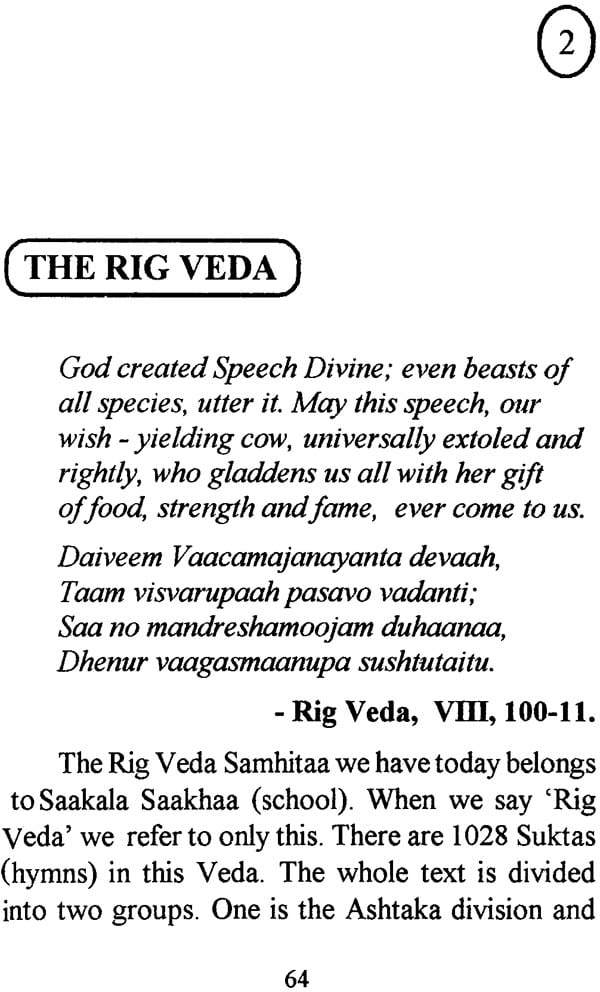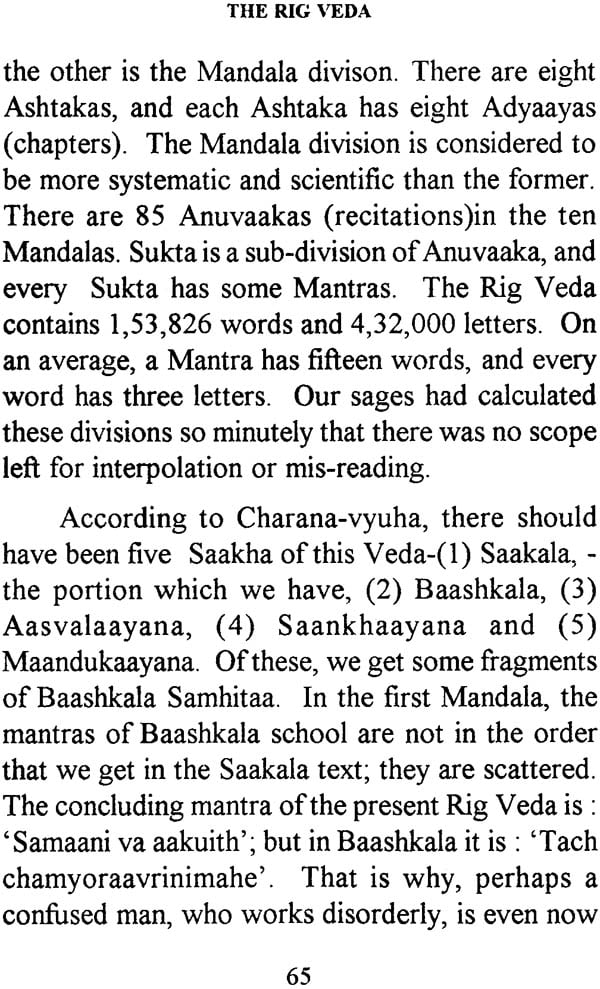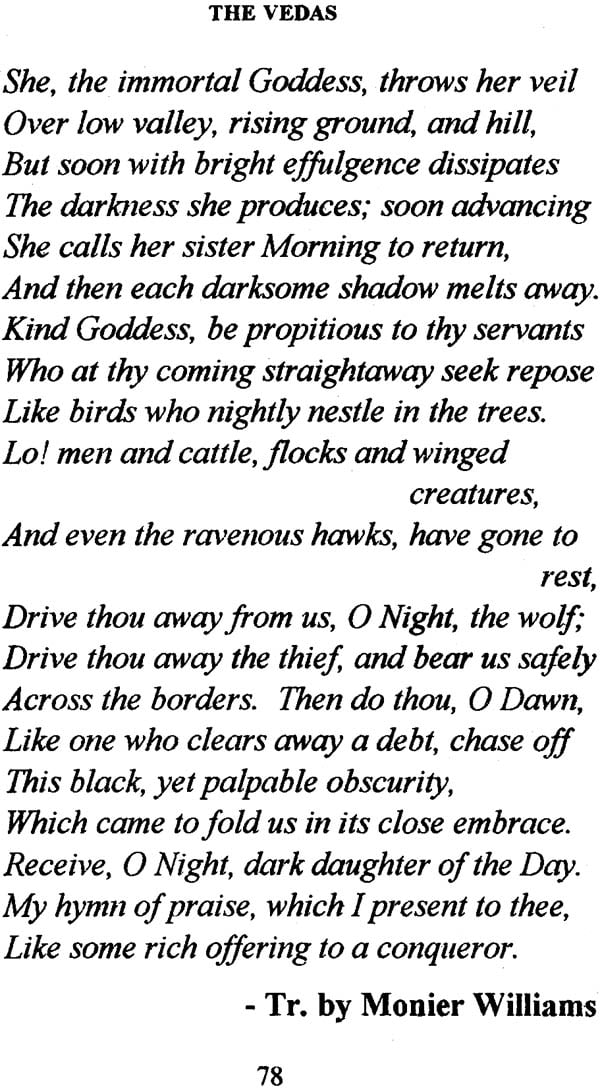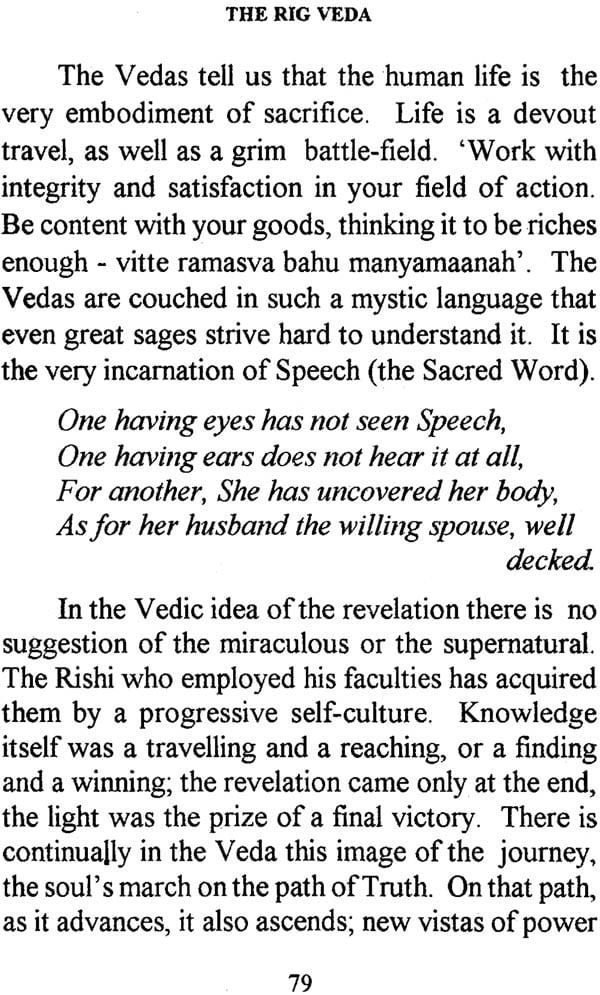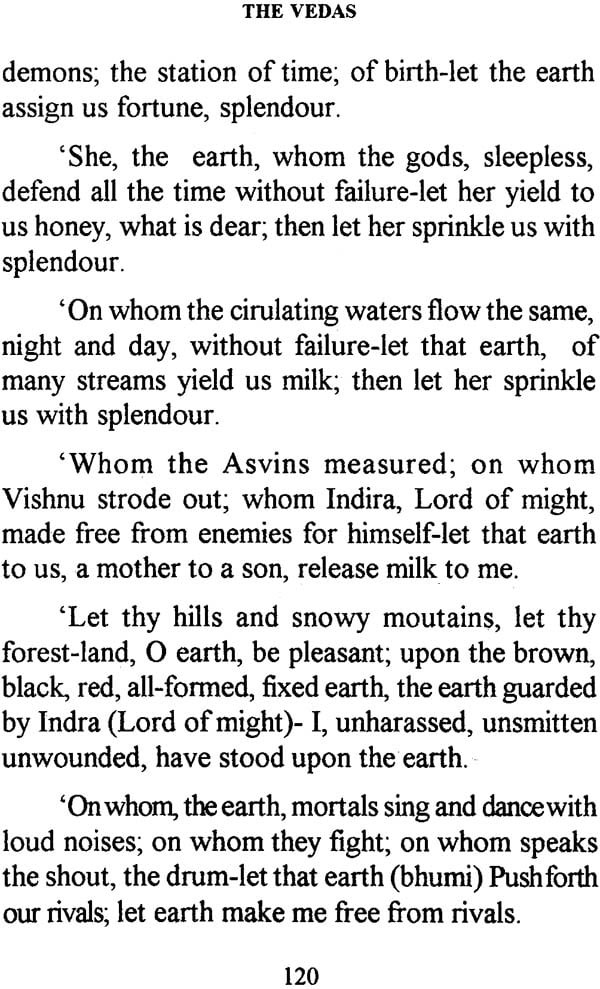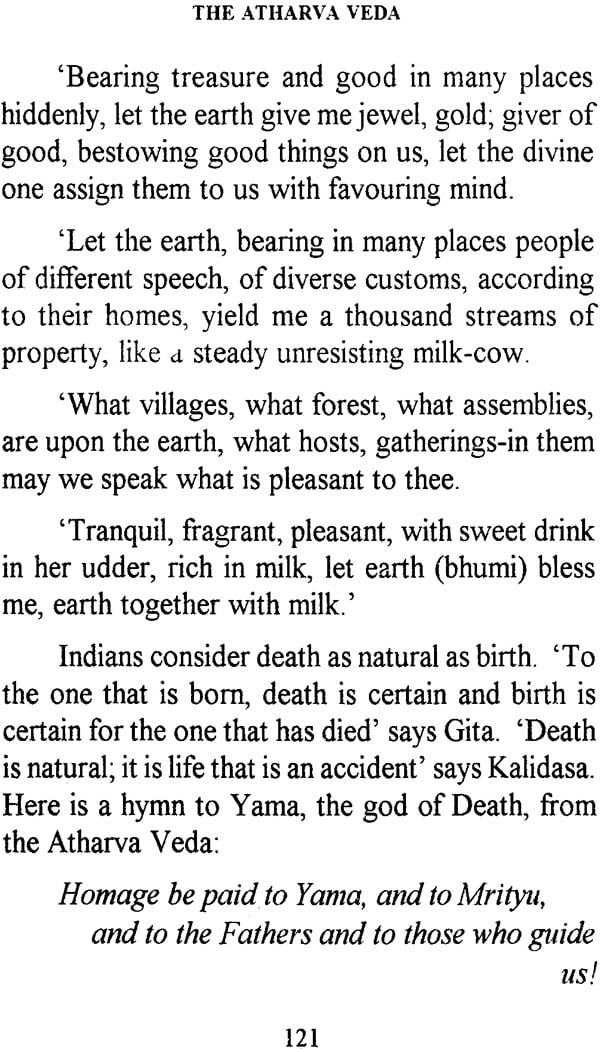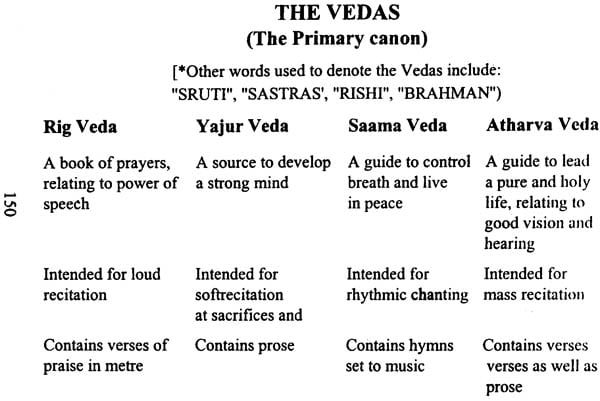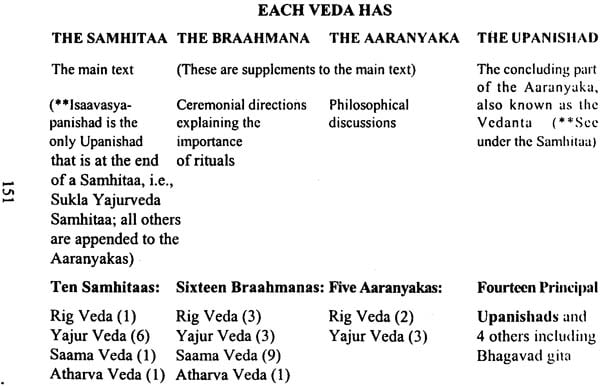
An Introduction to The Vedas
Book Specification
| Item Code: | NAM322 |
| Author: | K. S. Srinivasacharya |
| Publisher: | The Alliance Company |
| Language: | English |
| Edition: | 1999 |
| Pages: | 152 |
| Cover: | Hardcover |
| Other Details | 7.5 inch x 5.0 inch |
| Weight | 220 gm |
Book Description
Sri K.S. Srinivasacharya (February 15, 1913- July 28, 1999)
Sri K.S. Srinivasacharya, popularly known as ‘Kaa. Sri.Sri’, was born in Vrindaban, near Mathura in Uttar Pradesh, India. He was a scholar, linguist, author and a celebrated translator of V.S. Kandekar’s Marati literature in to the Tamil Language. In 1991 he won the Sahitya Academy Award for his Tamil translation of Kandekar’s novel entitled ‘Yayati’. He served as a sub-editor of the Tamil monthly ‘Kalaimagal’ for 37 years. He conducted scholarly research on the Vedic literature, Vaishnavism and Valmiki Ramayanam.
In 1973 he wrote a brochure called the ‘The Vedas-What and Why?’ This preliminary work, expanded by the author, has now taken the present form. The lucid delineation of the four Vedas, the link between the Vedas and modern science, suggestions to ways of preserving the great Vedic tradition, the need for an understanding of our life in terms of the Vedas and an extensive list of useful references cited in this booklet are some key features that are sure to appeal to the reader. As publishers we hope that this will earn acceptance among the Vedic scholars as a significant contribution of Sri K.S. Srinivasacharya to the world of Vedic literature.
Sri K.S. Srinivasacharya passed away in Nashik, Maharashtra, India. He will be remembered for his passion for languages and painstaking research and publications in various literary fields as well as Hindu religion and philosophy.
Lovers of the Vedas will be extremely delighted to read this small book on 'The Vedas'. Sri K.S. Srinivasacharya, the author of this book, has made a daring attempt to present the Vedas and their ideals-our ancient and modem, Eastern and Western, scientific and spiritual thoughts, in a small compass, with great success. Alas! The Bharat, the land of the Vedas, had neglected Vedic studies for the past three thousand years. The people absolutely lost interest in Vedic studies. Even the so-called reciters of the Vedas are confined only to the texts with utter indifference to the Vedic message. A great soul, this author, has dived deep into the Vedas with great courage, and culled wonderful thoughts and presented them to us.
Of course, many Western Universities and eminent Vedic scholars have demonstrated their interest in the Vedas profusely. But for want of the proper atmosphere, their scholarship hesitates to approach the Vedas in the right spirit. Among the thousands of books written by our traditional as well as modern scholars, this book stands as a challenge to the lover of the Vedas. How many Western scholars took interest in the Vedas? How many books were edited and written by them? We find the answer here. What are the Vedas? You find the answer here. The Vedas despite their vast expanse are contained within the pages of this little book.
Words cannot express adequately the value and the pre-eminence of this book. It is an eye-opener to all Vedic students of our time to understand what is what.
What are the Vedas ?
The Vedas are the repositories of the Sacred Divine knowledge, as well as the worldly wisdom, imparted to us by our ancient Vedic Rishis. The word Veda is derived from the root 'Vid'-to know'. So the word 'Veda' means 'sacred knowledge'. This term is applied to the Divine unwritten universal knowledge, which was communicated to Rishis, i.e. inspired seers or sages. The seers' saw' the supersensuous and subtle Vedic hymns as revealed to them, by their supernatural power acquired by austerities and deep contemplation - Rishir darsanaat. There were some who 'heard' the hymn as sounded in their inner self, with correct svaras (notations), and so they are called 'Sruta-rishis'. These sages were the active instruments through whom the hymns - the mantras - were spiritually transmitted. So, the Veda is a record of inspired wisdom and deep inner experience.
The Veda itself is called a 'Rishi' in some places, because it sees the supernatural which could not be seen by naked eyes. The Vedas were not created by any one, but are deemed to be the very breath of the Supreme Being.
The Veda is also called 'Brahman' meaning 'akshara' i.e. imperishable, industructible, undecaying and therefore a Veda is called as 'Akshara Brahman'. Every accent of every word in each hymn of the Vedas is preserved and recited to this day, as it was transmitted by the Vedic Rishis in days of yore. This is the unique and unsurpassed greatness of our Vedic literature. Not a word in the Vedas is altered from time immemorial.
The Vedas are preserved intact
The Vedas are preserved intact with great caution, giving importance to every accent of every word, because the change in an accent will bring a change in the meaning of the same word. There is a science of phonetics behind it. At early dawn every day the mantras are got by heart through oral instructions by the Vedic teacher. This is called 'Samhitaa-paatha' i.e. learning of the original Vedic text. Then the words of every hymn are split, which is called 'Pada-paatha'. Then the first word of every. hymn is added to the second, the second to the third, the third to the fourth and so on till each half of particular hymn is completed. This is called 'Krama-paatha'. One who studies 'Krama-paatha' was called a Kramavit'. Then the process is - first word with the second, second with the third; third with the second, and again second with the third and so on. This is called ‘Jataa-paatha'. One who studied' Jataa-paatha' was called a 'Jataa-vallabha'. The most difficult of these processes is the 'Ghana-paatha' which is recited by permutation and combination of the words of each hymn. One who studies 'Ghana-paatha' is called a 'Ghana-paathi'. Even today there are about two hundred Ghanapaathis in India, who could recite fluently their respective branches of the Vedas with remarkable memory. Thus the texts of the Vedas are kept intact through all these centuries down to us. 'The Vedic accent occupies a very important position in Comparative philology', says A.A. Macdonell (1851 - 1930).
Every Vedic hymn has its seer who saw it, its metre (chandas) and the Divinity (Devas) who is prayed by it. 'In muttered prayer and in offering an oblation mention of - the seer, the metre and the Divinity is a necessity; applying them wrongly one is here deprived of their fruit', says Brihaddevataa (viii, 134). But in practice, this is not strictly observed. A physician gives medicine to two of his patients; one takes it without knowing what it contains, and another takes it knowing its properties and reactions. Both are cured. But the latter man is known to be well-informed about the medicine. Similarly, whether we know about the seer, metre and Divinity of a hymn or not, we have the desired effect from it, but better is the result gained by a Vedic scholar who has a thorough knowledge of the hymn.
It is really a wonder that after scores of foreign invasions on the Indian sub-continent, and in spite of sheer neglect of Sanskrit studies by the people at large due to economic, social and political pressures, the vast Vedic literature still prevails with its pristine glory and holiness as ever.
The Vedas were written only lately
The Vedas were written on palm-leaves and birch-barks, after a very long time of their oral existence; only fourteen centuries back, illuminating commentaries on Vedic texts came into existence, perhaps because human memory began to weaken. No Vedic text was printed in India, till that famous German Sage of Vedic lore Dr. Friedrich Max Muller (1823 - 1900), published his first edition of the Rig Veda with Saayana's commentary in 1874, beginning his work in 1848. Dr. A. Weber brought in print 'Vaajasaneyi Samhitaa' in 1852, and 'Taitiriya Samhitaa' in 1871. Dr. L. Von Schroeder published critical editions of' ‘Maitraayani Samhitaa' in 1881-86, and 'Kaathaka-Samhitaa' in 1900-11. Professor Stevenson gave the text of the 'Raanaayaniya' branch of Sama Veda, with his English translation in 1842. Eugene Burnouf(1801-52) produced the German translation of the 'Kauthumiya' branch of Sama Veda in 1848. Roth and W.D. Whitney (1827- 94), edited 'Atharva Veda' in 1856.
Between 1849 and 1914, many western Sanskritists like Prof. M. Haug, Prof B. Linder, Dr.A.C. Burnell, Dr. H. Oertal, Prof A.F. Stenzler, D. Gaestra, Hillebrandt, Caland, R. Garbe, F. Knauer, M. Bloomfield, Dr. H. Wilson, H. Grassman, A. Ludwig, R.T.H. Griffith, Dr. H. Oldenburg, Dr. A.B. Keith, Dr. Jacobi, Prof. Theodore GoldStucker, Sir Monier Williams etc., were the pioneers in this field of the publication of Vedic texts, and they gave to the world most of the Vedic texts then available. These books paved the way for the Indian scholars to publish the critical editions of the Vedic texts.
The poetry of gods
'The Veda is the poetry of Gods. It neither fades, nor becomes stale by the passing of time.
'Devasys pasya kaavyam na mamaara na jeeryati. '
'The Vedas are truely epitomes of knowledge, gained and bequeathed by the Rishis of old, who were not bards or poets of common clay but inspired singers who poured out in living vocables the highest experience and realisations of the soul. They were seers, leaders of men, who had attained the high water-mark of a particular culture and civilization, and these hymnal records are just the finger-prints and sign posts of their spiritual and religious endeavour. The mantras of the Vedas are not of the usual human origin, their contents bespeak the presence of the Word beyond words. Their language is antique, but behind that antiquity lies the story of human language. The Vedas record the workings and manifestations of the Higher Knowledge; there may be much else besides, but that is secondary. They are pre-eminently scriptures of the Knowledge and practice of the Arts of God and Science of the Soul' observes Yogi Aurobindo.
What are the uses of the Vedas?
All knowledge which is not perceptible to us through our senses, and which could not be even approached by any stretch of imagination through our mind is imparted by the vedas. 'The uniqueness of the Vedas lies in the fact that they came to a man to solve any problem in life, which he could not solve by direct perception or any kind of imagination. -
Pratyakshena anumityaa vaa yastoopaayo na budhyate; Enam vidanti vedena tasmaad vedasya vedataa' - says Sayanacharya, the great commentator of most of the Vedas.
They teach us to lead a pure righteous life, with an insight into our Self They teach us to live a simple Divine life, in the midst of the Divine beings, in a Divine atmosphere. Professor Max Muller and Paul Deussen have testified to the fact the India has been the fountain-head of all philosophical thoughts, and that in the Vedas and the Upanishads may be found references to every philosophical conception that the western mind has since evolved. And, that is not all; the Vedas show us a way of spiritual life, a kindly Light, which leads us on, amid the encircling gloom. They help us to hold fast to the fundamental values for which our culture stands-Faith in God; Truth which is accord between mind and deed; Dedication which offers all movements of life as an offering to God; and Sublimation which purifies the body and mind and transmits instincts, passions and emotions into things of beauty.
This is an active l ife, and not a dreamy one. As the Upanishad puts it; 'In the midst of activity alone wilt thou desire to live a hundred years.
Kurvanneveha Karmaani jijiveshet satam samaah. '
